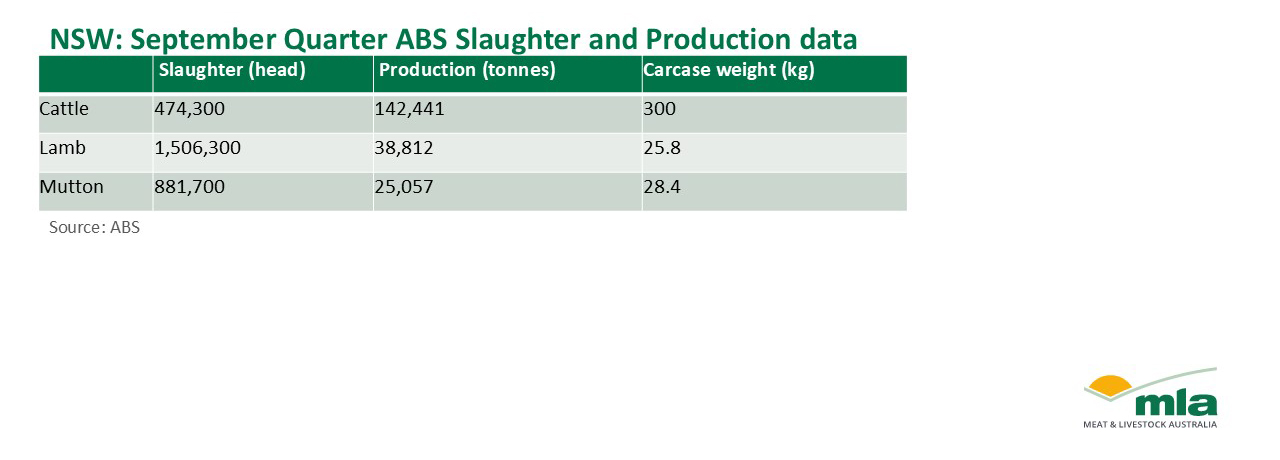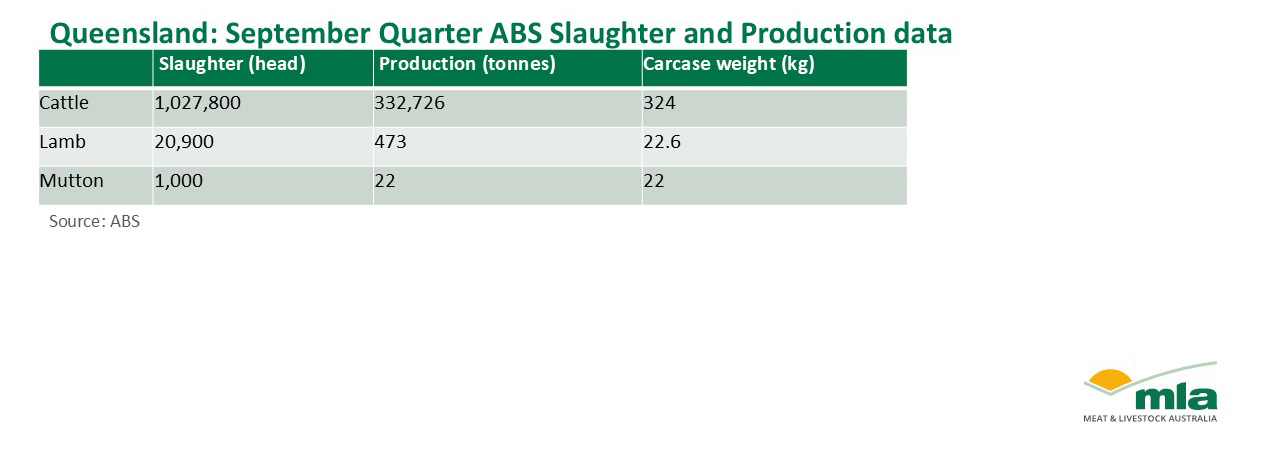Red meat production remains strong as beef herd enters destock
Key points
-
Record national beef production of 690,694 tonnes over three months.
-
Lamb and mutton production eased after a strong second quarter.
-
States varied in production trends, with climate systems impacting volumes.
The Australian Bureau of Statistics has released the September 2024 quarter slaughter and production volumes and value data, with the data showing that Australian red meat production remains strong. This article breaks down key national figures and covers each state’s key headlines on the previous quarter.
National – beef
The national beef herd is destocking. Female slaughter is currently 52% of total processing, remaining above 47% for consecutive years, indicating the national herd is in decline. The nature of this destock is that the herd has reached maturity following a three to four year rebuild. Older breeding cows continue to be turned off rather than a climate-driven destock, which would cause young heifers to be processed.
National beef production grew to new records, lifting 6% to 690,694 tonnes. This is the largest volume of beef produced in a three-month period on record. National slaughter remained elevated, though did not break records. Slaughter lifted 5% on the previous quarter for a figure of 2.2 million head.
Growth in carcase weights have enabled a divergence of slaughter and production. Weights have remained stable in the short-term at 308kg carcase weight (cwt). However, due to investments in genetics, efficiencies and growth in feedlots, average weights have been improving significantly over the last decade, with the average carcase around 30kg heavier than in 2014.
National – lamb
The June quarter is traditionally the largest lamb production quarter. Hence, it is not unexpected that after an extremely strong second quarter which broke records, the third quarter saw a slight reduction in figures.
National lamb slaughter eased 12% to 6.3 million head, and production is back 16% to 149,477 tonnes, thanks to a 4% ease in carcase weights to 23.6kg. Despite the reduction for both slaughter and production, the September quarter recorded the fifth largest volumes on record, indicating the sector is moving in a new norm.
National – mutton
Mutton slaughter eased 2% from the previous quarter but rose 28% from Q3 last year to 2.7 million head, the highest Q3 slaughter figure since 2006. Despite a reduction in throughput, production of mutton rose 2% from the previous quarter to 69,093 tonnes thanks to a lift in average mutton carcase weights to 25.5kg.
State-by-state play
Conditions across NSW led to the state faring relatively well in comparison to national averages.
Cattle slaughter and production across NSW lifted 5% to 474,300 head and 142,441 tonnes, which was 21% of national volumes, and tracking 29% above the five-year average. Carcase weights remained stable at 300kg despite a lift in female throughput. This is the state’s highest female slaughter ratio (FSR) since 2001, at 60%.
Lamb production and slaughter moved back just 4% and 5% to 1.5 million head and 38,812 tonnes. This was the smallest dip in volumes excluding Queensland stats, and the third largest lamb production quarter on record for the state. NSW accounted for 26% of production. Carcase weights came back to 25.8kg (largest average carcase) though are flat on year-ago levels, indicating steady quality.
NSW accounted for 36% of mutton production, the second largest after Victoria. The state processed 881,700 head for 25,057 tonnes. A 1kg lift in average carcase weights to 28.4kg, the largest average carcase weight, meant that production rose by 14% last year, over the 10% lift in slaughter.

In the September quarter Victoria produced more beef than they ever have before. Production lifted 9% on last quarter to 143,846 tonnes, by processing 489,900 head, though dipped to 21% national production. Carcases lifted to 294kg, despite a lift in female slaughter.
Victorian lamb slaughter eased 11% to 3.5 million for its fifth largest quarter, and 13% above 5-year averages. Victoria remains the largest state, producing 53% of all lamb for 79,241 tonnes. Conditions across the state impacted carcase weights which eased 5% to just below 22.9kg.
Victoria remained the largest state for sheep slaughter and production, accounting for 43% of slaughter (1.2 million head) and 40% of production (27,725 tonnes). Slaughter lifted substantially, with the uptick in Victorian slaughter accounting for 61% of the total year-on-year uptick in slaughter.

Conditions across Queensland were generally positive across the quarter supporting the largest lift in cattle slaughter compared to other states lifting 7% above 1 million for the first time since 2019.
Queensland is the largest producer of beef, making up 48% of total beef production. A 2% lift in carcase weight to 324kg cwt (largest national weight) supported record beef production of 332,726 tonnes, a 9% lift on the previous quarter. Female slaughter in the state eased to 44% showing herd stability.
As a small producer of sheepmeat, the state processed a stable volume of lamb at 20,900 head, for 473 tonnes, and 1,000 sheep for 22 tonnes of mutton.

Cattle slaughter in SA lifted 3% on last quarter, though 68% above the five-year quarterly average for a processing figure of 80,700 head. Production lifted 5% to 25,129 head and a 2% lift in carcase weights to 311kg.
SA was the most impacted state in terms of percentage changes in lamb slaughter and production. Slaughter dipped 29% to 564,600 while production was down 31% to 14,119 due to carcase weights. This ease was expected due to the tough conditions in the state impacting traditionally very stable regions. Producers have reported conditions across 2024 have been the driest on record. Carcase weights eased to 25kg.
Processors across the state were choosing mutton over lambs, which was reflected in Q3 data. Mutton slaughter lifted 39% and production lifted 34%, to 166,400 head and 4,075 tonnes respectively. Carcase weights lifted to 24.5kg.

There was a divergence in slaughter and production volumes. Despite a 3% lift in slaughter throughput to 112,700 head, beef production tipped back 1% to 30,831 tonnes. This dynamic was caused by a strong ease in carcase weights to 274kg, the smallest average weight across the country. Increased female slaughter likely led to these weights coming back.
In lamb, both slaughter and production dipped back 16% and 21%, respectively, for 692,800 processed, and 14,834 tonnes produced. Despite the ease, volumes remain well above five-year averages. Carcase weights eased to 21.4kg.
The state’s mutton slaughter eased on Q2 figures but rose 25% year-on-year to 464,300 head, while production rose 14% YoY to 11,682 tonnes. Notably, carcase weights in WA remained stable, though below the national average at 25.2kg.

Tasmania was the only state to experience declines in both cattle slaughter and production. Tasmanian cattle slaughter eased 11% to 55,700 head while production dipped back 9% to 15,720 tonnes. Dry conditions have resulted in cattle moved or sold out of state, as opposed to being finished in Tasmania. Carcase weights eased to 282kg.
Lamb slaughter eased 18% to 100,300 head and production eased 27% to 1,998 tonnes. This is due to a significant decline in average Tasmanian lamb carcases to 19.9kg, remaining the smallest average carcase.
Mutton slaughter tipped back 54% to 29,100 while production eased 58% to 532 tones. Despite this, both slaughter and production are both 50% above year-ago levels, as processors have moved to absorb a growing supply of sheep in the state. Mutton carcase weights eased to their lowest since 2016 at 18.3kg, remaining the lowest national average.




